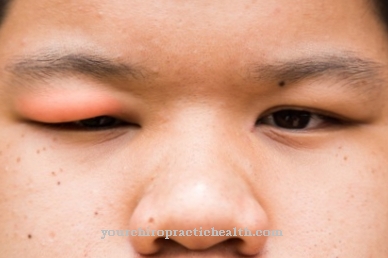Of the Hypertelorism is an abnormally large distance between the eyes, which does not necessarily have to be pathological. If the phenomenon occurs in the context of malformation syndromes, it has pathological significance and is usually due to a genetic mutation. Treatment of hypertelorism is usually not indicated, but in the case of severe hypertelorism it can improve the quality of life of the person affected.
What is hypertelorism?
When organs are unusually far apart, medicine is called hypertelorism. The term can generally be used to describe any pathologically large distance between organs. However, the term is used particularly often in relation to the eyes and then stands for an unusually wide interpupillary distance.
This is usually a congenital phenomenon that can be symptomatic of various malformation syndromes with predominant facial involvement. According to the definition, hypertelorism is always used when the distance between the centers of both pupils is more than 97 percentile above the distribution in the normal population.
The average interpupillary distance for women is 65 millimeters. For men, an average value of 70 millimeters applies. All values above this average are hypertelorism. The phenomenon need not have any disease value. The opposite of ocular hypertelorism is ocular hypertelorism, i.e. an abnormally small eye relief.
causes
Not all hypertolerism has pathological value. Symmetrical hypertolerism is usually caused by a physiological abnormality. Asymmetrical hypertelorisms are usually disease-related and refer to malformation syndromes with predominant involvement of the face. The cause of these disorders is genetic.
Mostly they are based on a gene mutation. For example, severe hypertelorism is a symptom of Cat Scream Syndrome, Wolf-Hirschhorn Syndrome, Zellweger Syndrome, Triploidy, Noonan Syndrome, and Gorlin-Goltz Syndrome. The phenomenon may just as well be characteristic of Fraser syndrome.Hypertelorism was also often documented in the context of trisomy 14, Edwards syndrome, trisomy 22 and LEOPARD syndrome.
The same is true for De Grouchy syndrome, Mabry syndrome, Crouzon's disease and Dubowitz syndrome or Down syndrome. The Alagille syndrome and the ATR-X syndrome are also associated with hypertelorism. In the context of the syndromes mentioned, the hypertelorism of the eyes is usually associated with a large number of other dysmorphisms of the facial area.
In many cases, patients with hypertelorism of the eyes are asymptomatic. This is especially true when the hypertelorism is isolated and only present to a small extent. In this context, medicine speaks of an anomaly with no disease value. Even pronounced hypertelorism does not necessarily have to impair the function of the eyes. The phenomenon is often associated with strabismus, however.
Hypertelorism is even more often associated with a telekanthus. This is an abnormally large distance between the outer corners of the eyes. Against the background of hypertelorism, there is not a primary, but a secondary telekanthus. Large hypertelorisms are perceived as a cosmetic impairment and can mainly show psychological symptoms as accompanying symptoms.
In the context of the above-mentioned syndromes, hypertelorism is usually associated with other malformations of the face. Which these are depends on the primary disease and its genetic mutation.
You can find your medication here
➔ Medicines for eye infectionsDiseases with this symptom
- Squint
- Cat cry syndrome
- Trisomy 22
- LEOPARD syndrome
- De Grouchy Syndrome
- Barber-Say Syndrome
- Alagille Syndrome
- ATR-X syndrome
- Wolf-Hirschhorn Syndrome
- Trisomy 14
- Edwards Syndrome
- Down syndrom
- Zellweger Syndrome
- Noonan's Syndrome
- Gorlin-Goltz Syndrome
- Fraser Syndrome
- Crouzon's syndromes
- Dubowitz syndrome
Diagnosis & course of disease
The doctor diagnoses pronounced hypertelorism by visual diagnosis. In less pronounced cases, the interpupillary distance must be measured as part of the diagnosis. If it is above the average values, then there is hypertelorism. Whether this hypertelorism has any disease value depends on the general picture of the patient.
If there are additional malformations of the face, the doctor determines the individual symptoms as part of the diagnosis and investigates the cause. This may require a molecular genetic analysis. The prognosis of an isolated and slightly pronounced hypertelorism is excellent. Pronounced hypertelorism often has psychological consequences.
If there is a syndrome, the prognosis depends on the type of causal mutation. A hypertelorism of the organs has a somewhat less favorable prognosis.
Complications
Hypertelorism, i.e. an increased distance between the eyes, is a symptom of many different genetic diseases. An example of a disease is cat cry syndrome. Affected children suffer from underweight, a small head, muscle weakness and heart defects. Life expectancy is not particularly affected, however.
However, there are mental and physical disabilities in the children, and those affected usually do not have an IQ over 40. Down syndrome (trisomy 21) can also be the cause of hypertelorism. Those affected have an increased risk of thyroid disease. Both an underactive thyroid and an overactive thyroid count.
In addition, children with Down's syndrome are at risk of developing leukemia later. Vision problems and infertility are also complications of this condition. Life expectancy is around 60 years. Edwards syndrome (trisomy 18) is also a cause of hypertelorism. Affected children have a greatly reduced life expectancy of just a few days to a few weeks. Few children live to be a few years old.
The children have a congenital heart defect, especially in the heart septum, so that heart failure occurs quickly. Zellweger's syndrome is also an option. This peroxismal disease is usually recognizable by clear signs on the newborn's face. In addition, there are cytes that form in the brain. Life expectancy is very poor and those affected hardly live to be a year old.
When should you go to the doctor?
The term hypertelorism describes an unusually large distance between the two eyes. Hypertelorism is rarely a disease in the form of a hereditary malformation. Hypertelorism is not necessarily a reason to see a doctor. In some cases, however, hypertelorism can have the character of a disability in that it affects the quality of life.
Asymmetrical - i.e. not equal - hypertelorism also has the effect of a disease. A check-up visit to the ophthalmologist is also recommended in the case of hypertelorism which is not subjectively impairing. In any case, a visit to the doctor goes without saying if you suffer from discomfort caused by hypertelorism.
Hypertelorism can lead to squinting, among other things, which can already be treated well by attending a so-called visual school and wearing corrective glasses. Occasionally, surgery may be indicated.
Hypertelorism can also be psychologically stressful due to a possible severe facial deformity. Consideration should therefore also be given to consulting a psychologist or psychotherapist. Since it is not possible to surgically reduce the interpupillary distance and thus remedy the hypertelorism, therapeutic discussions can help those affected to cope better with their situation.
Doctors & therapists in your area
Treatment & Therapy
Hypertelorism does not necessarily require intervention. If the patient is asymptomatic and does not feel affected by the abnormal interpupillary distance, therapy usually does not take place. If the interpupillary distance is particularly pronounced, the hypertelorism can be corrected surgically. This is especially true if the patient develops psychological problems.
If necessary, psychotherapy is first used against psychological problems so that the patient does not have to be treated invasively unnecessarily. If, despite psychotherapeutic care, the patient still perceives the hypertelorism as a severely impairing blemish, surgical correction takes place. The correction improves the quality of life of the person affected.
In the context of malformation syndromes, however, the correction of hypertelorism is usually put on the back burner. The primary treatment for these syndromes is the treatment of life-threatening symptoms. The situation is somewhat different with the hypertelorism of internal organs. Although these do not necessarily have to require a correction, in this case an intervention is more likely indicated.
Hypertelorism of the organs can also be compensated for using surgical procedures. The organs affected need to be repositioned, especially if the increased distance affects their function.
Outlook & forecast
In some cases, hypertelorism does not lead to any complications and is only an aesthetic, sometimes undesirable, symptom. In many cases, however, hypertelorism also results in deformities in the face. This has a negative effect on one's self-esteem and can lead to severe social and psychological problems. Sometimes this leads to depression.
In addition to the malformations, organs are damaged. Here patients may have weak hearts or weak muscles. The head itself is also shaped differently, often underweight. The underweight is favored by the underactive thyroid gland. As a result of these symptoms, the person concerned suffers from a reduced quality of life, which can be further reduced by visual disturbances and hearing damage.
Children suffer greatly from heart defects. They can suffer from heart failure, which in the worst case can lead to death. The treatment takes place primarily on the physical level and ensures the stability of all organs and functions of the body. However, no success can be guaranteed here.
If the patient only complains about the unusual distance between the eyes, treatment is not required. This is solely an aesthetic sensation.
You can find your medication here
➔ Medicines for eye infectionsprevention
Hypertelorism is usually not acquired, but occurs in the context of malformation syndromes. These diseases have a genetic basis. Genetic counseling in the family planning phase can therefore largely be described as a preventive measure.
You can do that yourself
Hypertelorism does not necessarily have to be treated. Some measures can help against the everyday problems associated with excessive eye relief. Conversations with friends and family members can help counteract a decreased self-esteem as a result of the anomaly.
A badly affecting beauty flaw can be dealt with as part of therapeutic measures. Special glasses reduce hypertelorism and allow those affected to have a comparatively normal everyday life despite the misalignment. In addition, the misalignment can only be reduced by surgical measures, provided that it does not resolve itself in the course of puberty. Genetic counseling as part of family planning reveals possible risk factors and facilitates the subsequent treatment of the child. The risk of inheriting hypertelorism can be reduced by not using anti-epileptic drugs in early pregnancy. In addition, the hypertelorism must be treated depending on the respective syndrome.
There is no effective home remedy for excessive eye relief, but typical accompanying symptoms such as atrophy, strabismus or hyperreflexia can be alleviated by appropriate therapeutic measures. The most effective means of self-help is the early diagnosis of the anomaly by an ophthalmologist.


.jpg)










.jpg)

.jpg)
.jpg)











.jpg)